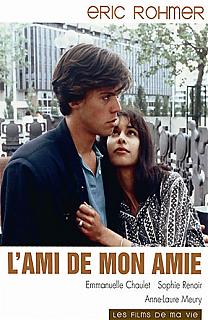 Eric Rohmer. Boyfriends and Girlfriends/L’ami de mon amie.
Eric Rohmer. Boyfriends and Girlfriends/L’ami de mon amie. 1987. Netflix DVD.
I’ve seen this before, but Rohmer is always worth returning to. A word about the title. Various American critics such as Roger Ebert or Jonathan Rosenbaum have translated it, but missed the point. The proverb is “
L’ami de mon ami est mon ami,” “my friend’s friend is my friend,” which in the French is sex-neutral. But the film title means “the [male] friend of my [female] friend,” which is ironic: the point is that when sex is involved the rules change and the proverb becomes problematic. The English titles for many of Rohmer's films lose an essential point--this one particularly.
It’s a little bit easier to confuse Rohmer's later films, the Proverbs/Proverbes series, with one another than is true with the earlier ones like
My Night at Maude’s or
Claire’s Knee, the Moral Tales/Contes moraux; and the Proverbs are accused of being superficial or “fluffy.” True, nothing Rohmer's made since has (on a certain level anyway) the depth of
My Night at Maude’s, with its complicated philosophical, moral, and religious discussions. But though their dialogue may seem simpler, the Proverbs are subtle. In this one (
L'ami de mon amie), the somewhat shy, sensitive Blanche (Emmanuelle Chaulet) is convinced she is in love with the dashing, accomplished Alexandre (François-Eric Gendron), even though he never gives any sign of more than a polite interest in her. Her new friend Léa (Sophie Renoir) is more down to earth and relaxed, and Léa seems at odds with her boyfriend, Fabien (Eric Viellard). Léa also happens to know Alexandre and be on friendly terms with him, which turns out to be significant later. The truth is that from the start the sweet, affectionate Fabien is enormously attracted to Blanche but it takes her a long time to realize that the way they click together not just in conversation but later in bed means they ought to be girlfriend and boyfriend, because she cherishes the fantasy of Alexandre. She also allows herself to be deterred by the fact that Léa and Fabien are nominally “together," and by the rule that the boyfriend of one’s friend is off limits, whatever that proverb says. But the signs have always been there that Léa and Fabien don’t really care for each other—or get along very well; but Fabien is too polite and well-behaved for either that, or his passion for Blanche, to be immediately obvious. A recurrent theme is how good manners are necessary but can slow the paths of love. The subtlety of the film is in every line and every expression of the actors, especially Vieillard, whose expressions and body language show his attraction to Blanche from their first encounter.
American reviews of
Boyfriends and Girlfriends have made much of the fact that the film takes place in one of the New Cities/Nouvelles Villes outside central Paris, but very different from the ghetto-like
banlieux where the riots have taken place. These New Cities are posh, elegant, but slightly sterile complexes where one can live and work and shop tantalizingly in view of La Defense and the Tour Eiffel. This new environment is interpreted by several American reviewers as corresponding to a "yuppie" superficiality in the characters, but nothing much is made of the setting in this film. It’s just a given, something more useful to neutralize the background and thus focus more completely on the nuances of the dialogue and the freshness and perfection of the young characters than to make any sociological point. There were superficial yuppies in the Moral Tales world too, even if most of those characters had messier hair and smoked more cigarettes. This is the difference between the Seventies and the Eighties. In Rohmer's 1984
Full Moon in Paris/Les nuits de la pleine lune the suburbs vs. central Paris is raised as an issue; and there is where Fabrice Lucchini’s (highly articulate and intellectual) character declares that Paris (meaning the old central Paris) is “the center of the world.” Admittedly that is a more complex film, but often, as in Rohmer’s 1986
Summer/Le rayon vert, a delicacy is achieved, which should definitely not be confused with superficiality, that highlights the sensitivity of a female character, memorably in
Le rayon vert that of the actress Marie Riviere. Later, in 1996, this character is Margot (Amanda Langlet), the sweet girl whom the fickle Gaspard (Melvil Poupaud) discounts because she isn’t sexy or hard-to-get enough, rather like the way Blanche discounts Fabien. These permutations and combinations are not so simple when you watch all Rohmer’s films and see the way he continually brings up a certain kind of character and kind of behavior and looks at it each time from a different angle, with different results.





